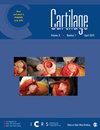Faster Bone Gap Union in Medial Opening Wedge High Tibial Osteotomy With 3D-Printed Synthetic Bioresorbable Polycaprolactone and Tricalcium Phosphate Osteotomy Gap Fillers Compared to Allogeneic Osteotomy Gap Fillers: A Retrospective Matched-Pair Cohort Study
IF 2.7
4区 医学
Q1 ORTHOPEDICS
引用次数: 0
Abstract
ObjectiveThe use of synthetic bone substitute material (BSM) as osteotomy gap fillers have been reported to improve outcomes in medial opening wedge high tibial osteotomy (MOWHTO). This study aims to evaluate the early radiological outcomes (bone union) and complication rates of the novel patient-specific 3D-printed honeycomb-structured polycaprolactone and tricalcium phosphate (PCL-TCP) synthetic graft compared to allogeneic bone grafts as an osteotomy gap filler in MOWHTO.MethodsA retrospective matched-pair analysis of patients who underwent MOWHTO with either PCL-TCP synthetic graft or allogenic femoral head allograft as osteotomy gap filler was performed. The osteotomy gap was split into equal zones (Zone 1-5), and bone union was evaluated on anteroposterior radiographs based on the van Hemert classification at 1, 3, 6, and 12 months postoperatively. Postoperative complications including infection, lateral hinge fractures, and persistent pain was measured. The study and control group were matched for age, smoking status, diabetes mellitus, and osteotomy gap size.ResultsSignificantly greater bone union progression was observed in the PCL-TCP group than in the allograft group at 1 month (Zones 1-3), 3 months (Zones 1-4), 6 months (Zones 1-2, 4), and 12 months (Zones 2-3, 5) postoperatively ( P < 0.05). No significant difference in complications rates was noted between the two groups at 1 year.ConclusionsBone union rates observed in patients who underwent MOWHTO with the PCL-TCP synthetic graft osteotomy gap filler were superior to those in the allograft group at 1 year postoperatively, with no significant difference in complication rates (postoperative infection, lateral hinge fractures, and persistent pain).使用三维打印合成生物可吸收聚己内酯和磷酸三钙截骨间隙填充物与同种异体截骨间隙填充物相比,内侧开口楔形高胫骨截骨术的骨间隙结合更快:回顾性配对队列研究
目的有报道称,使用合成骨替代材料(BSM)作为截骨间隙填充物可改善内侧开口楔形高胫骨截骨术(MOWHTO)的疗效。本研究旨在评估新型患者特异性三维打印蜂窝结构聚己内酯和磷酸三钙(PCL-TCP)合成移植物与同种异体骨移植物相比,作为 MOWHTO 截骨间隙填充物的早期放射学结果(骨结合)和并发症发生率。方法 对使用 PCL-TCP 合成移植物或异体股骨头同种异体骨移植物作为截骨间隙填充物进行 MOWHTO 的患者进行回顾性配对分析。截骨间隙被分割成相等的区域(1-5 区),并在术后 1、3、6 和 12 个月根据 van Hemert 分级法在正位X光片上评估骨结合情况。对术后并发症(包括感染、侧铰链骨折和持续疼痛)进行了测量。研究组和对照组在年龄、吸烟状况、糖尿病和截骨间隙大小等方面均匹配。结果在术后 1 个月(1-3 区)、3 个月(1-4 区)、6 个月(1-2 区、4 区)和 12 个月(2-3 区、5 区),观察到 PCL-TCP 组的骨结合进展明显高于同种异体移植组(P < 0.05)。结论使用 PCL-TCP 合成移植物截骨间隙填充物进行 MOWHTO 的患者术后 1 年的骨结合率优于同种异体移植物组,并发症发生率(术后感染、侧铰链骨折和持续疼痛)无明显差异。
本文章由计算机程序翻译,如有差异,请以英文原文为准。
求助全文
约1分钟内获得全文
求助全文
来源期刊

CARTILAGE
ORTHOPEDICS-
CiteScore
6.90
自引率
7.10%
发文量
80
期刊介绍:
CARTILAGE publishes articles related to the musculoskeletal system with particular attention to cartilage repair, development, function, degeneration, transplantation, and rehabilitation. The journal is a forum for the exchange of ideas for the many types of researchers and clinicians involved in cartilage biology and repair. A primary objective of CARTILAGE is to foster the cross-fertilization of the findings between clinical and basic sciences throughout the various disciplines involved in cartilage repair.
The journal publishes full length original manuscripts on all types of cartilage including articular, nasal, auricular, tracheal/bronchial, and intervertebral disc fibrocartilage. Manuscripts on clinical and laboratory research are welcome. Review articles, editorials, and letters are also encouraged. The ICRS envisages CARTILAGE as a forum for the exchange of knowledge among clinicians, scientists, patients, and researchers.
The International Cartilage Repair Society (ICRS) is dedicated to promotion, encouragement, and distribution of fundamental and applied research of cartilage in order to permit a better knowledge of function and dysfunction of articular cartilage and its repair.
 求助内容:
求助内容: 应助结果提醒方式:
应助结果提醒方式:


